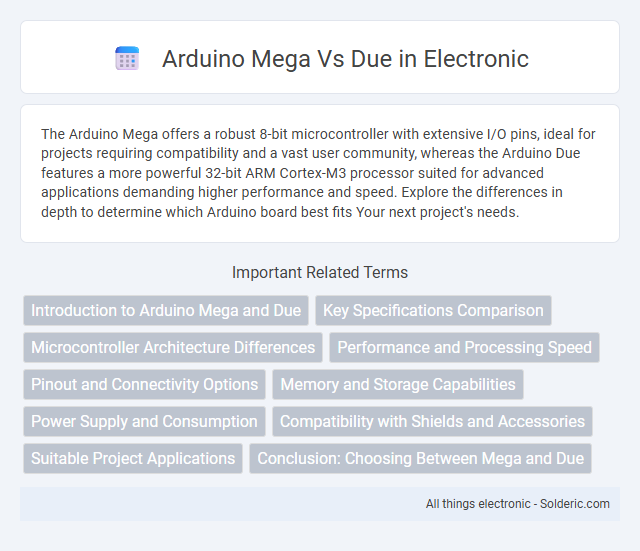The Arduino Mega offers a robust 8-bit microcontroller with extensive I/O pins, ideal for projects requiring compatibility and a vast user community, whereas the Arduino Due features a more powerful 32-bit ARM Cortex-M3 processor suited for advanced applications demanding higher performance and speed. Explore the differences in depth to determine which Arduino board best fits Your next project's needs.
Comparison Table
| Feature | Arduino Mega 2560 | Arduino Due |
|---|---|---|
| Microcontroller | ATmega2560 (8-bit) | Atmel SAM3X8E ARM Cortex-M3 (32-bit) |
| Operating Voltage | 5V | 3.3V |
| Flash Memory | 256 KB | 512 KB |
| SRAM | 8 KB | 96 KB |
| Clock Speed | 16 MHz | 84 MHz |
| Digital I/O Pins | 54 (15 PWM) | 54 (12 PWM) |
| Analog Input Pins | 16 | 12 (12-bit ADC) |
| Communication Interfaces | 4 UART, SPI, I2C | 4 UART, SPI, I2C, CAN, USB Host |
| USB Interface | USB 2.0 Full-Speed | USB 2.0 Full-Speed and USB Host |
| Price Range | Lower | Higher |
| Best For | Basic to intermediate projects requiring 5V logic | Advanced projects needing higher processing power and 3.3V |
Introduction to Arduino Mega and Due
Arduino Mega features a 16 MHz ATmega2560 microcontroller with 54 digital I/O pins and 16 analog inputs, ideal for complex projects requiring numerous connections. Arduino Due operates on a 32-bit ARM Cortex-M3 processor clocked at 84 MHz, offering higher processing power and 54 digital I/O pins alongside 12 analog inputs. Both boards target different project scales, with Mega suited for extensive component interfacing and Due optimized for speed and advanced computation.
Key Specifications Comparison
The Arduino Mega features an 8-bit ATmega2560 microcontroller with 256 KB of flash memory and 54 digital I/O pins, making it ideal for projects requiring multiple connections and moderate processing power. In contrast, the Arduino Due is powered by a 32-bit ARM Cortex-M3 processor running at 84 MHz, offering 512 KB of flash memory and 54 digital I/O pins with 12 analog inputs, enhancing performance for more complex and computation-intensive tasks. Both boards support various communication protocols, but the Due's native USB interface and higher clock speed provide superior capabilities for advanced applications.
Microcontroller Architecture Differences
The Arduino Mega is built around the 8-bit ATmega2560 microcontroller, featuring a 16 MHz clock speed and 256 KB of flash memory, which supports simpler and lower power applications. In contrast, the Arduino Due utilizes a 32-bit Atmel SAM3X8E ARM Cortex-M3 processor operating at 84 MHz with 512 KB of flash memory, enabling more complex and compute-intensive projects. The Due's advanced ARM architecture provides enhanced processing power, higher resolution ADCs, and more peripheral interfaces compared to the Mega's AVR-based microcontroller.
Performance and Processing Speed
The Arduino Mega features an 8-bit AVR microcontroller running at 16 MHz, ideal for basic projects requiring multiple I/O pins but limited in processing speed. In contrast, the Arduino Due is equipped with a 32-bit ARM Cortex-M3 processor clocked at 84 MHz, delivering significantly higher performance and faster execution of complex tasks. Your choice depends on the need for advanced processing power and speed, with the Due excelling in demanding applications.
Pinout and Connectivity Options
Arduino Mega offers 54 digital input/output pins and 16 analog inputs, making it ideal for projects requiring numerous connections, while Arduino Due provides 54 digital pins and 12 analog inputs with a higher resolution of 12-bit ADCs for more precise measurements. The Due features native USB hosting capabilities and supports CAN bus communication, enhancing connectivity options over the Mega's standard UART, SPI, and I2C interfaces. Your choice between the two depends on whether you prioritize extensive pin availability or advanced connectivity and faster processing capabilities.
Memory and Storage Capabilities
Arduino Mega features 256 KB of flash memory and 8 KB of SRAM, providing ample space for large sketches and multiple libraries. The Arduino Due offers 512 KB of flash memory and 96 KB of SRAM, significantly enhancing storage capacity and enabling more complex applications. Your choice between the two boards depends on whether you need greater memory and faster processing for advanced projects.
Power Supply and Consumption
The Arduino Mega operates at 5V with a recommended input voltage range of 7-12V and typically consumes around 70mA during operation. The Arduino Due runs at 3.3V, requires a 7-12V power supply, and has a higher current consumption close to 800mA due to its ARM Cortex-M3 processor. Power efficiency differences impact project design, especially for battery-powered or energy-sensitive applications.
Compatibility with Shields and Accessories
The Arduino Mega features an ATmega2560 microcontroller compatible with most standard shields designed for 5V logic, making it ideal for a wide range of legacy accessories. In contrast, the Arduino Due uses an ARM Cortex-M3 processor operating at 3.3V logic, which limits compatibility with many 5V shields without additional level shifting. Users seeking extensive shield compatibility typically prefer the Mega, while the Due offers advanced performance requiring careful accessory selection.
Suitable Project Applications
Arduino Mega suits projects requiring extensive I/O pins and compatibility with 5V logic, such as robotics, home automation, and 3D printing. Arduino Due excels in processing power with a 32-bit ARM Cortex-M3 core and 3.3V logic, ideal for complex applications like real-time audio processing, advanced sensor interfacing, and high-speed data acquisition. Choosing between them depends on project voltage requirements, computational needs, and peripheral control complexity.
Conclusion: Choosing Between Mega and Due
The Arduino Mega offers extensive digital and analog pins, making it ideal for projects requiring numerous sensor connections and basic processing power. The Arduino Due features a 32-bit ARM Cortex-M3 processor with higher clock speed and greater memory capacity, suited for complex computations and high-speed applications. Selecting between Mega and Due depends on project complexity, processing needs, and I/O requirements, with Mega favored for simpler, large-pin-count setups and Due chosen for advanced, performance-intensive tasks.
Arduino Mega vs Due Infographic

 solderic.com
solderic.com